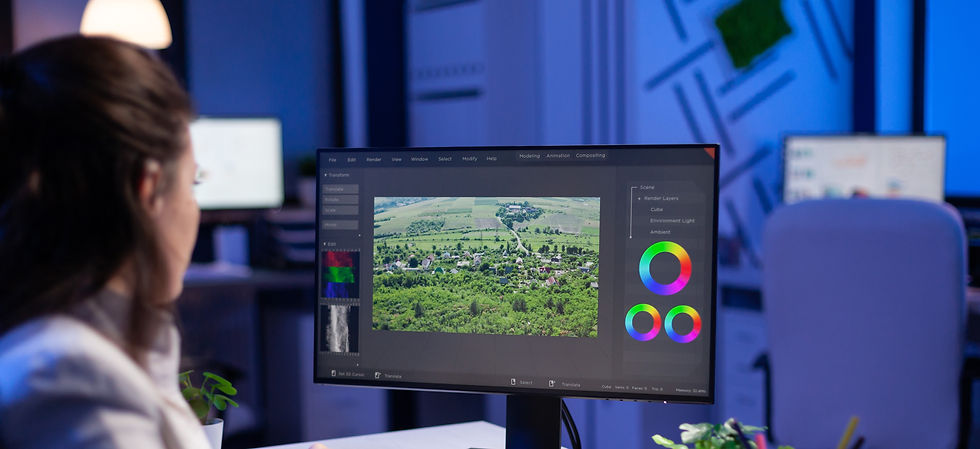What is a Ground Control Point?
- Antonio Liska

- Jun 15, 2022
- 3 min read
Updated: 8 hours ago
If you’re diving into the world of photogrammetry or surveying, you’ve likely come across the term ground control point. But what is a ground control point in photogrammetry, and why is it so critical to achieving accurate results? Let’s explore the essentials of ground control points in photogrammetry, their role in surveying, and how they ensure precision in mapping projects.
A ground control point (GCP) is a physical marker used to indicate a specific location on the ground. They are often placed at corners of a property or along straight lines, such as roadways. GCPs can be made from a variety of materials, such as metal pipes, rebar, or even survey flags. When using photogrammetry to survey an area, GCPs are placed at strategic locations in order to help the software calculate accurate measurements.
Why Are Ground Control Points Essential in Photogrammetry?
Ground control points in photogrammetry act as anchors that tie your digital model to the real world. Imagine trying to create a highly accurate 3D map or model without a reference point, without GCPs, your data could be skewed or misaligned. By strategically placing these markers, surveyors ensure that photogrammetry software can align images and measurements with real-world coordinates, delivering precise and reliable results. Whether you’re mapping a construction site, agricultural field, or urban landscape, understanding ground control point is the key to success.

GCPs are an important part of any surveying project that uses photogrammetry with inaccurate georeferenced imagery. Without GCPs or accurate camera external parameters, it would be very difficult to get accurate measurements. By placing GCPs at key locations, you can be sure that your measurements are as accurate as possible.
How Do Ground Control Points Work?
A GCP can be anything that is easily identifiable and referenced in the photogrammetry project. A precise point on the GCP should be easily and repeatably selectable from within photogrammetry software.
Typically, GCPs are designed to stand out in aerial imagery, often featuring high-contrast patterns or distinct shapes. This ensures that the software can consistently reference the same point across multiple images, creating a cohesive and accurate model.
To make a GCP useful, its exact coordinates must be recorded with high precision. This is where technologies like RTK (Real-Time Kinematic) GPS or PPK (Post-Processed Kinematic) workflows come into play. These methods allow surveyors to capture the exact location of a ground control point, ensuring that the data fed into photogrammetry software is as accurate as possible.

The Benefits of Using Ground Control Points in Photogrammetry
Incorporating ground control points in photogrammetry offers several advantages:
Enhanced Accuracy: GCPs provide fixed reference points that improve the precision of photogrammetric models, reducing errors in measurements.
Consistency Across Projects: By using GCPs, you ensure that your surveys are repeatable and consistent, even across large or complex sites.
Versatility: Whether you’re working on a small plot of land or a sprawling infrastructure project, GCPs can be adapted to suit any environment.
Cost-Effective Precision: With tools like RoboDot Touch and advanced GPS systems, capturing GCP coordinates is faster and more efficient than ever.
Tips for Using Ground Control Points Effectively
To maximize the benefits of ground control points, consider these best practices:
Strategic Placement: Place GCPs in areas with good visibility from multiple angles to ensure they’re captured in aerial imagery.
High-Contrast Markers: Use materials or patterns that stand out in images, making them easy for photogrammetry software to detect.
Accurate Coordinate Collection: Invest in reliable GPS tools like RTK or PPK systems to ensure precise coordinate data.
Regular Calibration: Verify the accuracy of your GCPs regularly to maintain the integrity of your photogrammetry project.
Ready to Elevate Your Surveying with Ground Control Points?
Understanding ground control point in photogrammetry is just the beginning. By leveraging ground control points with advanced tools like RoboDot Touch, you can streamline your surveying process and achieve unparalleled accuracy in your mapping projects. Whether you’re a seasoned surveyor or new to photogrammetry, mastering the use of GCPs will set your projects apart.
Reach out to learn how to efficiently survey and map with RoboDot Touch.




Comments